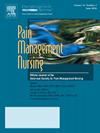Opioid related Transitions: Management considerations for patients with pain that utilize prescribed opioids
IF 1.6
4区 医学
Q2 NURSING
引用次数: 0
Abstract
Problem Statement
Pain is a leading reason people seek healthcare services, and approximately 20% of individuals with chronic pain in the United States rely on prescribed opioids as part of their pain management approach. Navigating healthcare is challenging for those that use an opioid for pain management and for the clinician requires multi-step processes and complex decision-making. Adding complexity for both patients and clinicians are transitions of care, which are movements between settings, services, practitioners and levels of care. Understanding, anticipating, and preparing for transitions that involve an opioid, called opioid related transitions (OrT), will assist nurses with optimizing pain care for people using opioids for pain management.
Purpose
The purpose of this session will be to describe OrT, explain the clinical importance of OrT for patients with pain that use opioids, and strategies for nurses, including advanced practice nurses, to optimize pain care when opioids are prescribed.
Methods
Following Rodgers Evolutionary method for concept analysis, key attributes of an OrT will be described. Case studies will be presented to underscore the defining attributes and clinical implications of OrT.
Results
OrT are a specific transition of care that involves a prescribed opioid and is a vulnerable period for patients with pain. OrT attributes occur during interactions between the patient and the prescribing clinician and include communication, responsibility, knowledge, risk, and decision-making.
Conclusions & Relevance to Pain Management
OrT can lead to fragmented and suboptimal care, raise patient safety concerns, increase the risk of adverse events, and result in suboptimal pain management. Enhancing nurse awareness of OrT involves identifying different types of OrT and clarifying the essential roles of clinicians and healthcare systems in supporting patients navigating these transitions.
Future Implications for Nursing Profession
Highlights of this talk include implications for nursing and clinician practice to support patients experiencing an OrT. Strategies discussed will include communication during transitions, needed education (e.g. opioid tapering, prescribing recommendations), assessing and monitoring medication response and risk mitigation.
求助全文
约1分钟内获得全文
求助全文
来源期刊

Pain Management Nursing
医学-护理
CiteScore
3.00
自引率
5.90%
发文量
187
审稿时长
>12 weeks
期刊介绍:
This peer-reviewed journal offers a unique focus on the realm of pain management as it applies to nursing. Original and review articles from experts in the field offer key insights in the areas of clinical practice, advocacy, education, administration, and research. Additional features include practice guidelines and pharmacology updates.
 求助内容:
求助内容: 应助结果提醒方式:
应助结果提醒方式:


